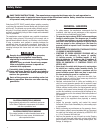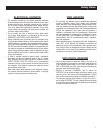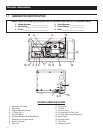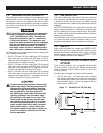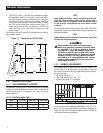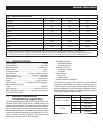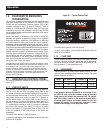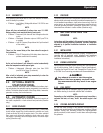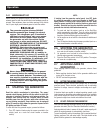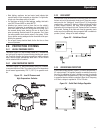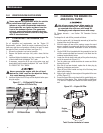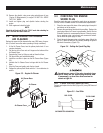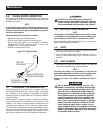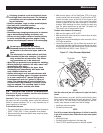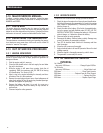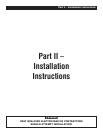
10
2.4.5 ENGINE EXHAUST GAS
Before starting the generator engine, be sure there is no way for
exhaust gases to enter the vehicle interior and endanger people or
animals. Close windows, doors and other openings in the vehicle
that, if open, might permit exhaust gases to enter the vehicle.
n
The generator engine releases DEADLY
carbon monoxide gas through its exhaust
system. This dangerous gas, if breathed in
sufficient concentrations, can cause uncon-
sciousness or even death. Never operate
the generator set with the vehicle inside
any garage or other enclosed area. DO NOT
OPERATE THE GENERATOR IF THE EXHAUST
SYSTEM IS LEAKING OR HAS BEEN
DAMAGED. Shut down the generator and
do not operate it until it has been inspected
and repaired. SYMPTOMS OF CARBON
MONOXIDE POISONING ARE (a) inability to
think coherently, (b) nausea, (c) vomiting, (d)
twitching muscles, (e) throbbing temples, (f)
dizziness, (g) headaches, (h) weakness, and
(i) sleepiness. IF EXPERIENCING ANY OF
THESE SYMPTOMS, MOVE INTO FRESH AIR
IMMEDIATELY. IF SYMPTOMS PERSIST, GET
MEDICAL HELP.
n
Never sleep in the vehicle while the genset
is running unless the vehicle has a working
carbon monoxide detector. The exhaust sys-
tem must be installed in accordance with the
genset installation manual. Make sure there
is ample fresh air when operating the genset
in a confined area.
2.5 STARTING THE GENERATOR
NOTE:
Read the vehicle manufacturer’s instructions. The owner/
operator should become familiar with the vehicle in which this
generator is installed. Differences exist between vehicles. For
example, some vehicles may use a transfer switch to isolate
dockside power from the generator, while other vehicles may
use an isolating receptacle. Some vehicles may be equipped
with a DC converter which allows the generator to power certain
DC lighting and other DC loads.
To crank and start the generator engine, proceed as follows:
1. Turn OFF electrical loads using the means provided in the
vehicle (such as a main line circuit breaker or transfer
switch).
NOTE:
If starting from the generator control panel, turn OFF loads
by setting the generator’s main circuit breaker to the OFF (or
open) position. If starting from a remote panel, turn OFF loads
using the means provided in the vehicle (such as a main circuit
breaker). Electrical load circuits should be turned ON after the
generator has started, stabilized and warmed up.
2. To crank and start the engine, push up on the Start/Stop
switch momentarily and release. There is a delay as the fuel
pump primes and the generator automatically begins the start
sequence (Note the flashing light on the switch.).
3. Let the engine run at no-load for a few minutes to stabilize and
warm up.
4. Turn ON electrical loads using the means provided (such as a
main circuit breaker or transfer switch).
2.6 STOPPING THE GENERATOR
1. Turn OFF all electrical loads using the means provided (such
as a main circuit breaker or transfer switch).
2. Let generator run at no-load for a few minutes, to stabilize
internal engine generator temperatures.
3. Place the Start/Stop switch in its STOP position. The engine
will come to a complete stop.
2.7 APPLYING LOADS TO
GENERATOR
When applying electrical loads to the generator, observe these
guidelines:
Before applying electrical loads, let the generator stabilize and •
warm up for a minute or two.
DO NOT overload the generator.•
2.7.1 LETTING THE ENGINE STABILIZE
The generator supplies correct rated voltage only at the proper
governed speed. Some electrical appliances may be extremely
sensitive to voltage. Incorrect voltages can damage such appli-
ances.
If electrical loads are applied at reduced operating speeds, such
loads imposed on the engine when sufficient power is not available
may shorten engine life. Never turn ON electrical loads until after
the generator engine has started and stabilized at no-load.
2.7.2 DO NOT OVERLOAD THE GENERATOR
Read the rated wattage/amperage capacity of the generator on the
generator data label (See the "Generator Identification" section.).
Applying electrical loads in excess of the unit’s rated capacity will
cause the engine/generator to automatically shut down.
To avoid overloading, add up the wattage of all connected electrical
lighting, appliance, tool and motor loads. This total should not be
greater than the generator’s rated wattage capacity.
Operation



